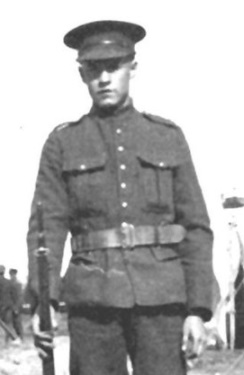He was one of the best that God could send. A loving brother, a faithful friend.
Private Charles Edwin Jones 820384 born 1 October 1896 in Listowel, Ontario and attested on 15 March 1916 at Fort Frances, Port Arthur. At the time, he stood 5’7″ tall, 160 pounds, with dark complexion, brown eyes and dark brown hair. An Engineers Apprentice, and a Baptist. His mother, Mrs. Susan Jones resided at 459 Tupper Street, Port Arthur, Ontario.

Charles embarked Halifax on 28 April 1917, disembarking Liverpool on 7 May 1917 and transferred to the 18th Reserve Battalion at Dibgate. Private Charles Edwin Jones T.O.S. by 44th Battalion along with 143 other reinforcements, joining his unit at Hersin-Coupigny, on 5 July 1917, with special training commencing the following day.
44th Battalion
Organized in February 1915 under the command of Lieutenant-Colonel Edward Robert Wayland. Mobilized at Winnipeg. Recruited in Winnipeg. Then, a draft of 5 officers and 249 other ranks sent to England on 4 September 1915. Once again, a draft of 10 officers and 500 other ranks from 44th and 45th Battalions sent to England on 1 June 1915. Finally, embarked from Halifax 23 October 1915 aboard SS LAPLAND.

The 44th Battalion disembarked England 30 October 1915, with a strength of 36 officers, and 1076 other ranks. Then, disembarked in France 10 August 1916 with the 4th Canadian Division, 10th Canadian Infantry Brigade. Then, reinforced by 18th Canadian Reserve Battalion, and returned to England 23 April 1919. Finally, disembarked in Canada 4 June 1919 and demobilized 6 June 1919. In addition, published “Gin Pills” from November 1915 to May 1916 at Bramshott Camp Brass and pipe bands.

Hersin-Coupigny
The 44th Battalion perpetuated by The Carleton Light Infantry which, in 1936, amalgamated with The York Regiment to form The Carleton and York Regiment. Then, perpetuation changed 11 September 1969 to The Royal Winnipeg Rifles.

Battalion sports are played on the afternoon of 9 July, and Private Charles Edwin Jones assembles with his unit along the route of H.M. the King on 11 July. Then, on 3 August 1917, the 44th Battalion relieves the 47th Battalion at Chateau de la Haie.

Moving to Lievin on 17 August 1917, Charles finally in the action, seeing his first casualty in his unit, wounded slightly by night shelling.

Green Crassier
Charles participates in his first attack at 03h00 on 23 August 1917. On this day, is company obtained the objective at Green Crassier in only 30 minutes, casualties negligible, owing much to the cover of darkness. Then, moving onto Alpaca Trench, the 44th Battalion’s luck runs out, running into determined resistance, and worse, daylight; their casualties are heavy, as the battalion is very much out-numbered, but Private Charles Edwin Jones comes through.

Then, they are relieved after two days of action, and fall back to Zouave Valley near Chateau de la Haie, moving there on 30 August.

Battle of Hill 70
Battle of Hill 70, 15 – 20 August 1917 (video). 2nd Canadian Infantry Brigade troops receiving hot tea at a Soup and Tea Kitchen within 1/4 mile of front line on night before attack on Hill 70, 14 August 1917. Canadian leads in a Boche whose nerves have been shattered during our advance on Hill 70, 15 August 1917. In addition, wounded Canadians who took part in capture of Hill 70 leaving Casualty Clearing Station for Blighty. Then, General Sir Arthur Currie watching his men who took Hill 70, marching to rest camp after being relieved, Hersin-Coupigny. Canadian Mobile Veterinary Section caring for Horses wounded at Hill 70. The Mayor, Aldermen and prominent business men of Souchez return after two years to dig for their money buried by the French before evacuating.
Suicide Valley
Charles back in the trenches for five days at Suicide Valley on 2 September 1917. A few men per day are wounded, but no one killed. Private Charles Edwin Jones has his first taste of gas during his next tour of the trenches on 10 September 1917, with the former commanding officer, Lt-Col Reginald Davies DSO, admitted to Field Ambulance. Moving to Avion later in the month, shelling becomes a constant irritant.


During a night working party, Charles sniped and admitted to No.7 C.C.S., with a penetrating GSW right chest and shoulder, 21 September 1917. Then, condition improved, at No.7 C.C.S., 20 October 1917. Tragically, Private Charles Edwin Jones’s improvement is only slight, for he died of wounds at Calais, 28 October 1917.

Charles buried in one of the most nationally-diverse CWGC cemeteries on the Western Front, Les Baraques Military Cemetery, Pas-de-Calais, France.
Les Baraques Military Cemetery
Joseph Leng
Among the most diverse headstones in any CWGC cemetery, the grave of seven-year-old Joseph Leng. Joseph and his mother came to France to visit his father, Sapper Joseph Leng, stationed in Calais, still awaiting demobilization following the Armistice. While playing, young Joseph fell into the canal at Audricq on 2 October 1919 and unfortunately, efforts to revive him failed. Later, the Leng family successfully appealed to the CWGC to allow their son to be placed in the cemetery as a Victim of War – one of many such casualties buried in Les Baraques Military Cemetery, Sangatte. Finally, most of the stories of other Victims of War remain untold.
More
Please subscribe to CEFRG to be notified by email when there are new posts. Subscription is free, and your email kept confidential.
